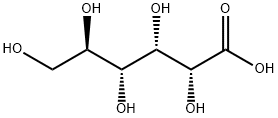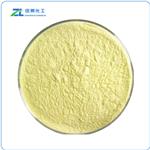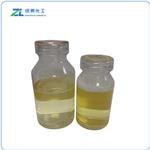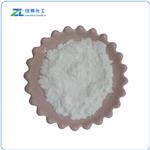Description
Gluconic acid (also known as gluconate) is an organic compound occurring widely in nature arising from the glucose oxidation. It is naturally found in fruit, honey and wine. It can also be used as a food additive to regulate acidity and a cleaning agent in alkaline solution. Its calcium salt, calcium gluconate can be used to treat burns from hydrofluoric acid and avoid necrosis of deep tissues as well as treating the verapamil poisoning and hypocalcemia in hospitalized patient. Some salts of gluconate can also be used to treat malaria (quinidine gluconate) and anemia (ferrous gluconate). In microbiology, gluconate is a common carbon source that can be supplemented to the medium for cell growth.
References
[1]Mandelstam, J. "The repression of constitutive β-galactosidase in Escherichia coli by glucose and other carbon sources." Biochemical Journal82.3 (1962): 489.
[2]Ghotbi, Mohammad Yeganeh, et al. "LDH-intercalated d-gluconate: Generation of a new food additive-inorganic nanohybrid compound." Journal of Physics and Chemistry of Solids 70.6 (2009): 948-954.
[3]Perkins, C. M. "Serious verapamil poisoning: treatment with intravenous calcium gluconate." British medical journal 2.6145 (1978): 1127.
[4]Broner, Cynthia W., et al. "A prospective, randomized, double-blind comparison of calcium chloride and calcium gluconate therapies for hypocalcemia in critically ill children." The Journal of pediatrics 117.6 (1990): 986-989.
[5]Miller, K. D., A. E. Greenberg, and C. C. Campbell. "Treatment of severe malaria in the United States with a continuous infusion of quinidine gluconate and exchange transfusion. " New England Journal of Medicine321.2(1989):65-70.
[6]Gillespie RS(Driscoll Children's Hospital, Corpus Christi, TX 78411, USA. kidneys@rrmail.com), and J. M. Symons. "Sodium ferric gluconate for post-transplant anemia in pediatric and young adult renal transplant recipients." Pediatric Transplantation 9.1(2005):43–46.
Description
Gluconic acid is an organic compound with molecular formula C
6H
12O
7 and condensed structural formula HOCH
2(CHOH)
4COOH. It is one of the 16 stereoisomers of 2,3,4,5,6-penta hydroxy hexanoic acid.
In aqueous solution at neutral pH, gluconic acid forms the gluconate ion. The salts of gluconic acid are known as "gluconates". Gluconic acid, gluconate salts, and gluconate esters occur widely in nature because such species arise from the oxidation of glucose. Some drugs are injected in the form of gluconates.
Chemical Properties
clear yellow to brownish-yellow solution
Chemical Properties
d-Gluconic acid is an acid sugar composed of white crystals with
a milk-acidic taste. In aqueous solutions, it is in equilibrium with gamma- and delta-gluconolactones. It is prepared by enzymatic
oxidation of glucose and strains of the microorganisms used to
supply the enzyme action are nonpathogenic and nontoxicogenic
to man or other animals. This substance is used as a component
of bottle rinsing formulations, at levels not to exceed good manufacturing
practice.
An FDA letter to a trade association revoking affirmation of general
recognition of safety in dietary supplements was dated April
9, 1970.
Physical properties
The chemical structure of gluconic acid consists of a six-carbon chain with five hydroxyl groups terminating in a carboxylic acid group. In aqueous solution, gluconic acid exists in equilibrium with the cyclic ester glucono delta-lactone.
Occurrence
Gluconic acid occurs naturally in fruit, honey, kombucha tea, and wine. As a food additive ( E574 ), it is an acidity regulator. It is also used in cleaning products where it dissolves mineral deposits especially in alkaline solution. The gluconate anion chelates Ca
2+,Fe
2+, Al
3+, and other metals. In 1929 Horace Terhune Herrick developed a process for producing the salt by fermentation.
Calcium gluconate, in the form of a gel, is used to treat burns from hydrofluoric acid; calcium gluconate injections may be used for more severe cases to avoid necrosis of deep tissues. Quinine gluconate is a salt between gluconic acid and quinine, which is used for intramuscular injection in the treatment of malaria. Zinc gluconate injections are used to neuter male dogs. Iron gluconate injections have been proposed in the past to treat anemia.
Uses
Gluconic Acid is an acidulant that is a mild organic acid which is the
hydrolyzed form of glucono-delta-lactone. it is prepared by the
fermentation of dextrose, whereby the physiological d-form is
produced. it is soluble in water with a solubility of 100 g/100 ml at
20°c. it has a mild taste and at 1% has a ph of 2.8. it functions as
an antioxidant and enhances the function of other antioxidants.
in beverages, syrups, and wine, it can eliminate calcium turbidities.
it is used as a leavening component in cake mixes, and as an acid
component in dry-mix desserts and dry beverage mixes.
Uses
Gluconic acid occurs naturally in fruit, honey, and wine. As a food additive it is an acidity regulator. It is also used in cleaning products.
Uses
A chemical used in glycolytic pathway studies.
Definition
A soluble
crystalline organic acid made by the oxidation
of glucose (using specific molds). It is
used in paint strippers.
Definition
gluconic acid: An opticallyactive hydroxycarboxylic acid,CH
2(OH)(CHOH)
4COOH. It is the carboxylicacid corresponding to the aldosesugar glucose, and can be madeby the action of certain moulds.
brand name
Calglucon (Novartis).
Biotechnological Production
Currently, gluconic acid is commercially produced by submerged fed-batch cultivations
of Aspergillus niger using glucose as substrate. A. niger produces
citric acid and gluconic acid growing on glucose. The product concentration and
yields of the product depend on the fermentation conditions. For optimal gluconic
acid production, high glucose concentrations (110–250 g.L-1), low concentrations
of nitrogen and phosphorus in the medium, a limitation of metal ion concentrations,
a pH value in the range of 4.5–6.5, and high aeration rates for the oxygen
supply are needed.
Much research has been carried out to find new ways for cheaper production.
Different microorganisms have been studied (e.g. G. oxydans, Z. mobilis, A.
methanolicous, and P. fluorescence. Moreover, new microbial strains
have been developed by mutagenesis or genetic engineering. Additionally,
the fermentation process and recovery have been optimized. New inexpensive
substrates (e.g. cornstarch, grape or banana must, figs, and cheese whey)
have been tested.
One example of a new and efficient production process of gluconic acid is the
cultivation of Aureobasidium pullulans growing on glucose. Using a
continuous process with biomass retention by crossover filtration, a product concentration of 375 g.L-1, a yield of 0.83 g of gluconic acid per gram of glucose, and
a productivity of 17 g.L-1.h-1 could be achieved at a residence time of 22 h. In
this process, 100 % of the glucose is converted. This process might be
interesting for industrial applications. In continuous gluconic acid production with
immobilized mycelia of A. niger, product concentrations of 120–140 g.L-1 have
been achieved.
Flammability and Explosibility
Non flammable




